
The Adriatic Campaign of World War I was a naval campaign fought between the Central Powers and the Mediterranean squadrons of Great Britain, France, the Kingdom of Italy, Australia, and the United States.
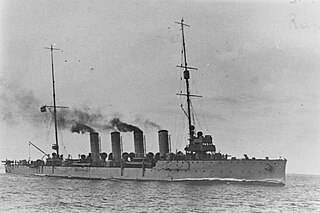
SMS Novara was a Novara-class scout cruiser of the Austro-Hungarian Navy which served during World War I. Built by the Danubius shipyard between December 1912 and January 1915, Novara was the third and final member of her class to enter service, some six months after the start of the war. She was armed with a battery of nine 10-centimeter (3.9 in) guns and had a top speed of 27 knots.
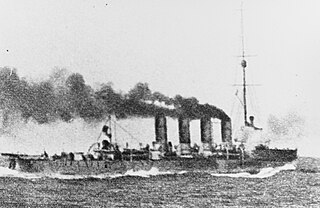
The Battle of the Strait of Otranto of 1917 was the result of an Austro-Hungarian raid on the Otranto Barrage, an Allied naval blockade of the Strait of Otranto. The battle took place on 15 May 1917, and was the largest surface action in the Adriatic Sea during World War I. The Otranto Barrage was a fixed barrier, composed of lightly armed drifters with anti-submarine nets coupled with minefields and supported by Allied naval patrols.

Varese was a Giuseppe Garibaldi-class armored cruiser built for the Royal Italian Navy in the 1890s. The ship made several deployments to the Eastern Mediterranean and the Levant before the start of the Italo-Turkish War of 1911–12. She supported ground forces in the occupations of Tripoli and Homs in Libya. Varese may have bombarded Beirut and did bombard the defenses of the Dardanelles during the war. She also provided naval gunfire support for the Italian Army in Libya. During World War I, the ship's activities were limited by the threat of Austro-Hungarian submarines and Varese became a training ship in 1920. She was struck from the naval register in 1923 and subsequently scrapped.

Regina Elena was the lead ship of her class of pre-dreadnought battleships built for the Italian Regia Marina. The ship was built by the La Spezia shipyard between 1901 and 1907, and was armed with a main battery of two 305 mm (12 in) guns and twelve 203 mm (8 in) guns. She was quite fast for the period, with a top speed of nearly 21 knots. Regina Elena was active in both the Italo-Turkish War with the Ottoman Empire in 1911–1912, where she participated in the Italian conquest of Cyrenaica, and World War I in 1915–1918, where she saw no action due to the threat of submarines in the narrow confines of the Adriatic Sea. She was retained for a few years after the war, but was ultimately stricken in February 1923 and broken up for scrap.

Vittorio Emanuele was an Italian pre-dreadnought battleship, laid down in 1901, launched in 1904 and completed in 1908. She was the second member of the Regina Elena class, which included three other vessels: Regina Elena, Napoli, and Roma. Vittorio Emmanuele was armed with a main battery of two 305 mm (12 in) guns and twelve 203 mm (8 in) guns. She was quite fast for the period, with a top speed of nearly 21 knots.

Roma was an Italian pre-dreadnought battleship, laid down in 1903, launched in 1907 and completed in 1908. She was the third member of the Regina Elena class, which included three other vessels: Regina Elena, Napoli, and Vittorio Emanuele. Roma was armed with a main battery of two 305 mm (12 in) guns and twelve 203 mm (8 in) guns. She was quite fast for the period, with a top speed of nearly 21 knots.
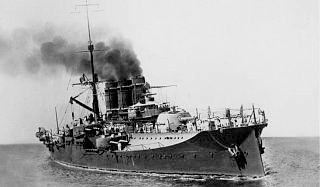
Napoli was a Regina Elena-class pre-dreadnought battleship built for the Italian Regia Marina in 1903–08. She was the last member of the four-ship class, which included the lead ship Regina Elena, Vittorio Emanuele, and Roma. Napoli was armed with a main battery of two 305 mm (12 in) and twelve 203 Mm (126,138 mi) guns, and was capable of a top speed of 21 knots.

SMS Helgoland was a Novara-class scout cruiser built for the Austro-Hungarian Navy right before World War I. Helgoland participated in several raids on the ships defending the Strait of Otranto, including the Battle of the Strait of Otranto in May 1917. She was transferred to Italy in 1920 in accordance with the peace treaties ending World War I and renamed Brindisi. After modifications, the ship was assigned to the squadron responsible for the Eastern Mediterranean until 1924. She spent the next five years based in Libya and Italy before Brindisi was disarmed and turned into a depot ship in 1929. The ship was stricken from the Navy List in 1937 and later broken up.
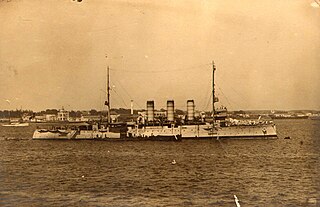
Libia was a protected cruiser built in Italy in the 1900s. The ship had originally been laid down in 1907 for the Ottoman Navy and was to have been named Drama, and was based on the Ottoman cruiser Hamidiye. She had not been completed by the outbreak of the Italo-Turkish War in 1911 and so she was seized by the Italian Regia Marina and was completed in 1913. The ship was armed with two 152 mm (6 in) and eight 120 mm (4.7 in) guns, and was capable of a top speed of over 22 knots.

The Nino Bixio class was a pair of protected cruisers built for the Italian Regia Marina in the 1910s. The two ships, Nino Bixio, and Marsala, were built in Castellammare between 1911 and 1914. They were intended to serve as scouts for the main Italian fleet, and as such required a high top speed. They were overweight as built, which prevented them from reaching their intended maximum speed. They were a disappointment in service, especially compared to the earlier—and faster—cruiser Quarto, which cut their careers short.

Nino Bixio was a protected cruiser built by the Italian Regia Marina in the early 1910s. She was the lead ship of the Nino Bixio class, which were built as scouts for the main Italian fleet. She was equipped with a main battery of six 120-millimeter (4.7 in) guns and had a top speed in excess of 26 knots, but her engines proved to be troublesome in service. Nino Bixio saw service during World War I and briefly engaged the Austro-Hungarian cruiser SMS Helgoland in 1915. Her career was cut short in the post-war period due to severe cuts to the Italian naval budget, coupled with her unreliable engines. Nino Bixio was stricken from the naval register in March 1929 and sold for scrap.

Quarto was a unique protected cruiser built by the Italian Regia Marina in the 1910s. Her keel was laid in November 1909, she was launched in August 1911, and was completed in March 1913. She was the first Italian cruiser to be equipped with steam turbines, which gave her a top speed of 28 knots. Her high speed was a requirement for the role in which she was designed to serve: a scout for the main Italian fleet.
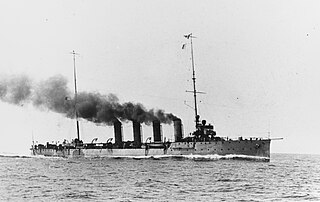
SMS Saida was a Novara-class scout cruiser built for the Austro-Hungarian Navy in the early 1910s. The ship was armed with a main battery of nine 10 cm (3.9 in) guns, and six twin 53.3 cm (21.0 in) torpedo tubes were added in 1917. She was built by the Cantiere Navale Triestino shipyard from 1911 to 1914, entering service days after the outbreak of World War I. She spent the war as a flotilla leader, conducting raids and patrols in the narrow waters of the Adriatic Sea.

Bisson was the name ship of her class of destroyers built for the French Navy during the 1910s, entering service in 1913. She served in the Mediterranean Sea during the First World War, sinking the Austro-Hungarian submarine U-3 on 6 July 1915 and took part in the Battle of Durazzo in December 1915 and the Battle of the Strait of Otranto in May 1917. She was stricken in 1933 and scrapped in 1939.

The Novara class was a class of three scout cruisers built for the Austro-Hungarian Navy. Named for the Battle of Novara, the class comprised SMS Saida, SMS Helgoland, and SMS Novara. Construction started on the ships shortly before World War I; Saida and Helgoland were both laid down in 1911, Novara followed in 1912. Two of the three warships were built in the Ganz-Danubius shipyard in Fiume; Saida was built in the Cantiere Navale Triestino shipyard in Monfalcone. The Novara-class ships hold the distinction for being the last cruisers constructed by the Austro-Hungarian Navy.

SMS Csepel was one of six Tátra-class destroyers built for the kaiserliche und königliche Kriegsmarine shortly before the First World War. Completed in 1913, she helped to sink an Italian destroyer during the action off Vieste in May 1915 after Italy declared war on Austria-Hungary. Two months later the ship participated in an unsuccessful attempt to recapture a small island in the central Adriatic Sea from the Italians. In November and early December Csepel was one of the ships conducting raids off the Albanian coast to interdict the supply lines between Italy and Albania. She was hit one time during the First Battle of Durazzo in late December. Her stern was blown off by a French submarine in early 1916 and her repairs were not completed until early 1917.

SMS Balaton was one of six Tátra-class destroyers built for the kaiserliche und königliche Kriegsmarine shortly before the First World War. Completed in 1913, she did not participate in the attacks on the Italian mainland after Italy declared war on Austria-Hungary in May 1915. Two months later the ship bombarded a small island in the Central Adriatic Sea during an unsuccessful attempt to recapture it from the Italians. In November and early December Balaton was one of the ships conducting raids off the Albanian coast to interdict the supply lines between Italy and Albania. She played a minor role in the 1st Battle of Durazzo in late December. Balaton participated in several unsuccessful raids on the Otranto Barrage in 1917, although she sank an ammunition ship during the Battle of the Strait of Otranto. She was transferred to Italy in 1920 in accordance with the peace treaties ending the war and renamed Zenson. The Regia Marina used her for spare parts; she was discarded in 1923 and subsequently scrapped.

SMS Tátra was the lead ship of her class of six destroyers built for the kaiserliche und königliche Kriegsmarine shortly before the First World War. Completed in 1913, she helped to sink an Italian destroyer during the action off Vieste in May 1915 after Italy declared war on Austria-Hungary. Two months later the ship participated in an unsuccessful attempt to recapture a small island in the Central Adriatic Sea from the Italians. In November and early December Tátra was one of the ships conducting raids off the Albanian coast to interdict the supply lines between Italy and Albania. During the early stages of the 1st Battle of Durazzo in late December, the ship was tasked to tow her one of her sister ships that had been crippled by a mine. She was forced to abandon her sister when the Austro-Hungarians were spotted by a strong force of Allied ships and had to evade their pursuit. Tátra participated in several unsuccessful raids on the Otranto Barrage in 1917. She was transferred to Italy in 1920 in accordance with the peace treaties ending the war and renamed Fasana. The Regia Marina used her for spare parts; she was discarded in 1923 and subsequently scrapped.



















